OCZ Vertex 4 Review (256GB, 512GB)
by Anand Lal Shimpi on April 4, 2012 9:00 AM ESTSequential Read/Write Speed
To measure sequential performance I ran a 1 minute long 128KB sequential test over the entire span of the drive at a queue depth of 1. The results reported are in average MB/s over the entire test length.
As impressive as the random read/write speeds were, at low queue depths the Vertex 4's sequential read speed is problematic:

Curious as to what's going on, I ran AS-SSD and came away with much better results:
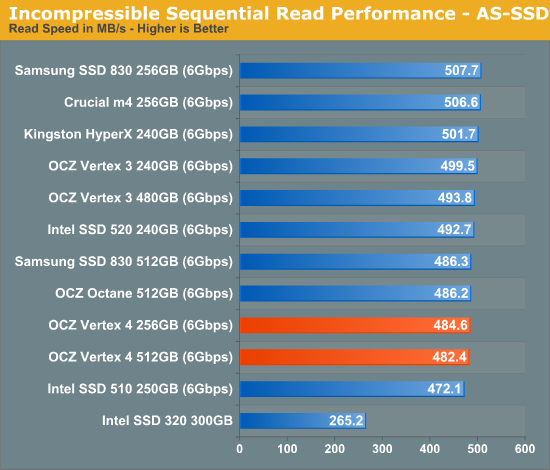
Finally I turn to ATTO, giving me the answer I'm looking for. The Vertex 4's sequential read speed is slow at low queue depths with certain workloads, move to larger transfer sizes or high queue depths and the problem resolves itself:
The problem is that many sequential read operations for client workloads occur at 64 – 128KB transfer sizes, and at a queue depth of 1 - 3. Looking at the ATTO data above you'll see that this is exactly the weak point of the Vertex 4.
I went back to Iometer and varied queue depth with our 128KB sequential read test and got a good characterization of the Vertex 4's large block, sequential read performance:
The Vertex 4 performs better with heavier workloads. While other drives extract enough parallelism to deliver fairly high performance with only a single IO in the queue, the Vertex 4 needs 2 or more for large block sequential reads. Heavier read workloads do wonderfully on the drive, ironically enough it's the lighter workloads that are a problem. It's the exact opposite of what we're used to seeing. As this seemed like a bit of an oversight, I presented OCZ with my data and got some clarification.
Everest 2 was optimized primarily for non-light workloads where higher queuing is to be expected. Extending performance gains to lower queue depths is indeed possible (the Everest 1 based Octane obviously does fine here) but it wasn't deemed a priority for the initial firmware release. OCZ instead felt it was far more important to have a high-end alternative to SandForce in its lineup. Given that we're still seeing some isolated issues on non-Intel SF-2281 drives, the sense of urgency does make sense.
There are two causes for the lower than expected, low queue depth sequential read performance. First, OCZ doesn't currently enable NCQ streaming for queue depths less than 3. This one is a simple fix. Secondly, the Everest 2 doesn't currently allow pipelined read access from more than 8 concurrent NAND die. For larger transfers and queue depths this isn't an issue, but smaller transfers and lower queue depths end up delivering much lower than expected performance.
To confirm that I wasn't crazy and the Vertex 4 was capable of high, real-world sequential read speeds I created a simple test. I took a 3GB archive and copied it from the Vertex 4 to a RAM drive (to eliminate any write speed bottlenecks). The Vertex 4's performance was very good:
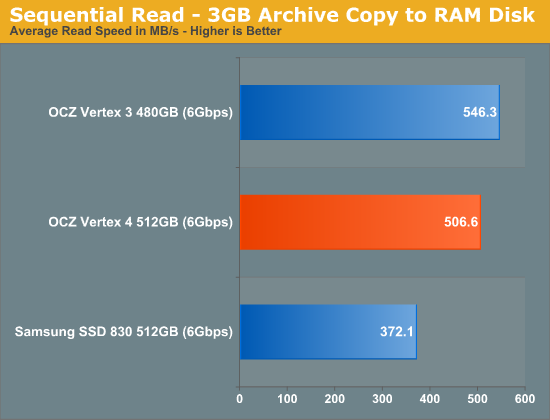
Clearly the Vertex 4 is capable of reading at very high rates – particularly when it matters, however the current firmware doesn't seem tuned for any sort of low queue depth operation.
Both of these issues are apparently being worked on at the time of publication and should be rolled into the next firmware release for the drive (due out sometime in late April). Again, OCZ's aim was to deliver a high-end drive that could be offered as an alternative to the Vertex 3 as quickly as possible.
Update: Many have been reporting that the Vertex 4's performance is dependent on having an active partition on the drive due to its NCQ streaming support. While this is true, it's not the reason you'll see gains in synthetic tests like Iometer. If you don't fill the drive with valid data before conducting read tests, the Vertex 4 returns lower performance numbers. Running Iometer on a live partition requires that the drive is first filled with data before the benchmark runs, similar to what we do for our Iometer read tests anyway. The chart below shows the difference in performance between running an Iometer sequential read test on a physical disk (no partition), an NTFS partition on the same drive and finally the physical disk after all LBAs have been written to:
Notice how the NTFS and RAW+precondition lines are identical, it's because the reason for the performance gain here isn't NCQ streaming but rather the presence of valid data that you're reading back. Most SSDs tend to give unrealistically high performance numbers if you read from them immediately following a secure erase so we always precondition our drives before running Iometer. The Vertex 4 just happens to do the opposite, but this has no bearing on real world performance as you'll always be reading actual files in actual use.
Despite the shortcomings with low queue depth sequential read performance, the Vertex 4 dominated our sequential write tests, even at low queue depths. Only the Samsung SSD 830 is able to compete:
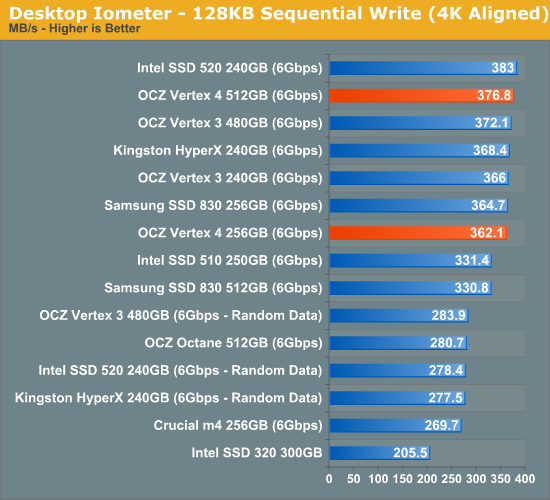
Technically the SF-2281 drives equal the Vertex 4's performance, but that's only with highly compressible data. Large sequential writes are very often composed of already compressed data, which makes the real world performance advantage of the Vertex 4 tangible.
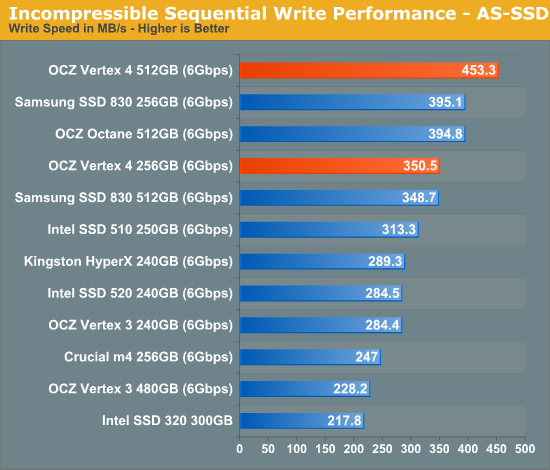
AS-SSD gives us another taste of the performance of incompressible data, which again is very good on the Vertex 4. As far as writes are concerned, there's really no beating the Vertex 4.


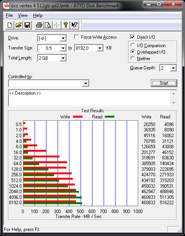
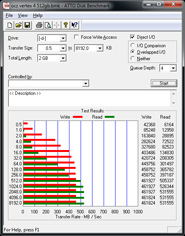

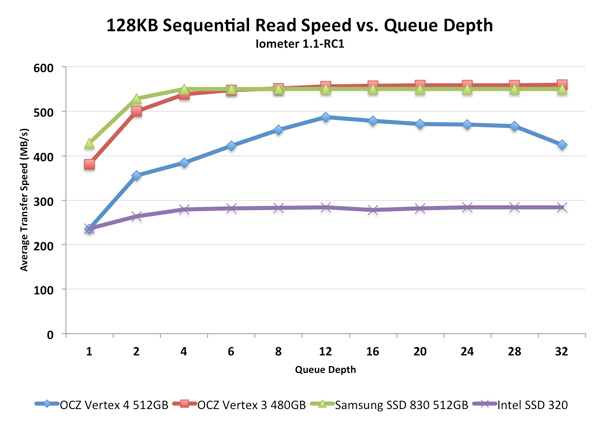
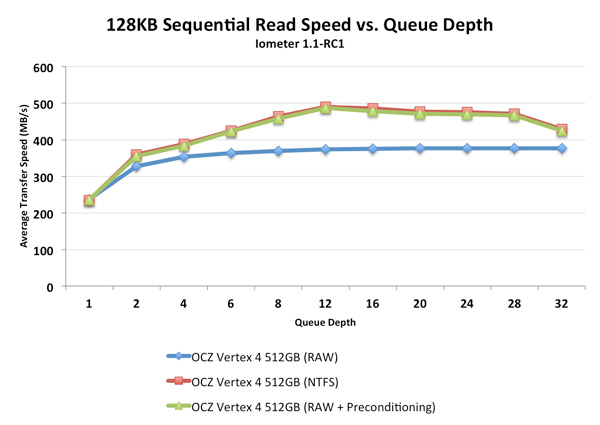








127 Comments
View All Comments
Kristian Vättö - Wednesday, April 4, 2012 - link
Samsung 830 is "a lot" faster, see our Heavy and Light benches. In real world, you will probably not notice the difference unless you do something I/O intensive. Personally, I've been recommending both Crucial m4 and Samsung 830. Crucial is great if you want to save a few bucks but otherwise Samsung is better. I think Anand has been using the Samsung in his main system for months now and haven't had issues, so that may be a reason as well. After all, we speak based on our own experience.kristof007 - Thursday, April 5, 2012 - link
I've been looking around for articles and just looked at bench marks (ignore the M3 and Vertex 4 reviews) and it seemed like the Crucial m4 was hands down the best drive. I purchased it yesterday via Newegg for $299 (it was on sale). Sounds like I won't be disappointed.I was wondering if you guys could maybe have like a top 3 list for SSDs (or heck .. for all categories) with quick pro's and con's for what is out at the moment and what is the best one performance wise.
By the way, I haven't been reading much AT lately, but I've seen a few of your articles and would like to thank you for your work!
nathanddrews - Wednesday, April 4, 2012 - link
The 830 offers up nearly the best "real world" disk busy performance in both the light and heavy benchmarks and has proven to be extremely reliable and consistent without being very expensive. The M4 is great... but a bit outdated performance-wise (not as fast as the 830).antef - Wednesday, April 4, 2012 - link
Thanks for the replies. I guess I saw them as trading places a good bit in the benchmarks, but I do see that the 830 often comes out on top. I guess I figured the performance difference is practically nil for mainstream uses and the M4 seems more highly reviewed. But the 830 has been out for less time, so that may improve over time.nathanddrews - Wednesday, April 4, 2012 - link
That's just it - the differences in overall performance aren't likely to keep one awake at night. In the case of a person that has never used an SSD, just about any SSD available online today will completely shock and awe.An SSD that is 20% faster than another SSD which are both 900% faster than a 5400RPM HDD... not a big deal.
antef - Wednesday, April 4, 2012 - link
"Shock and awe" is the correct way to describe my feelings the first time I saw Windows boot in 3 seconds. :)beginner99 - Wednesday, April 4, 2012 - link
Price wise for average user the m4 is the best bang for the buck. Here its the cheapest sata-3 128 GB drive and 20$ cheaper than the Samsung. Also m4 uses less power, eg better for a laptop.ExarKun333 - Wednesday, April 4, 2012 - link
Looks like a trade-off that gave-up read performance for write performance with poor power consumption. Based on the charts, the HyperX 240GB or the Intel 520 would be better all-around options. The OCZ name also doesn't inspire a lot of confidence when it comes to reliability or support. They will really need up their game for customer service this generation to build some confidence in them.alan1476 - Wednesday, April 4, 2012 - link
If you are not impressed by this drive the review did not do this drive justice. If someone reviews a drive especially an SSD you have to understand the inner workings and just how it applys itself to applications in the real world. This SSD is ground breaking.cknobman - Wednesday, April 4, 2012 - link
I see no Sandforce 512gb drives shown in the performance charts.Its pretty common knowledge that SSD performance goes up with capacity and showcasing the Vertex 4 512gb drive against either smaller SSD's or older controllers makes it look better than it likely is.
Did anyone notice the abysmal speeds for the 120gb model???
I also noticed pretty high power consumption.
I don't consider this review proper until you place a 2nd Gen 512gb SandForce drive in the charts to compare directly against the 512gb Vertex 4 drive.